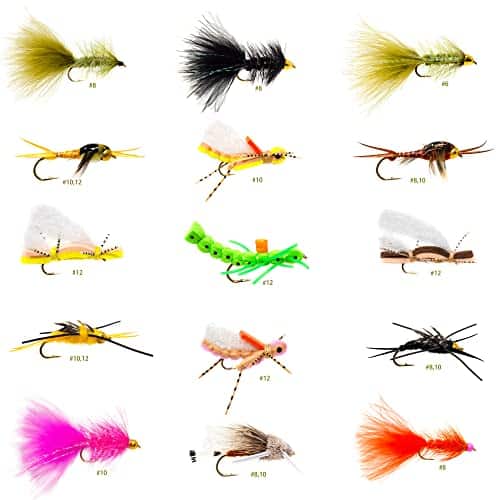Key Takeaways
- Choosing the right flies is crucial for successful fly fishing
- Flies are categorized into different types, including dry flies, wet flies, nymphs, streamers, caddis flies, and hopper flies
- A diverse selection of flies, including different sizes and patterns, increases the chances of a successful catch

Producing Fly Fishing Flies Assortment
Producing Fly Fishing Flies Assortment | Dry Flies, Wet Flies, Nymphs, Streamers Flies, Caddis, Hopper | Trout, Bass, Steelhead Fishing Lure Set
The Thrill of Fly Fishing: Choosing the Right Flies for Success
When it comes to fly fishing, the right selection of flies can make all the difference between a successful day on the water and going home empty-handed. Each type of fly serves a specific purpose, imitating different types of insects or prey that fish are naturally attracted to. In this article, we’ll explore the various types of flies and provide insights into their effectiveness based on feedback from real anglers.
Dry Flies: Imitating Floating Insects
Dry flies are designed to imitate insects that float on the surface of the water. They are meant to mimic adult insects such as mayflies, caddisflies, and stoneflies. By presenting a dry fly on top of the water, anglers can entice fish to rise and strike. Our assortment of flies includes popular patterns like the Parachute Adams and Yellow Humpy, which have received rave reviews for their effectiveness in attracting trout.
Wet Flies: Mimicking Drowning Insects
Wet flies are designed to imitate insects that have fallen below the water’s surface and are struggling or drowning. These flies are often used in streams or rivers where fish are actively feeding below the surface. With a variety of wet fly designs in our assortment, anglers have reported great success in catching trout and other species.
Nymphs: Underwater Imitations of Immature Insects
Nymphs are essential flies for fly fishing enthusiasts. They imitate immature insects that live underwater, such as mayfly nymphs, stonefly nymphs, and caddisfly larvae. These flies are typically fished below the surface and can be highly effective in fooling trout. Our assortment includes a range of nymph patterns, allowing anglers to match the hatch and increase their chances of a successful catch.
Streamers: Imitating Small Fish or Prey
Streamers are designed to imitate small fish, leeches, or other prey that larger fish feed on. These flies are typically larger in size and create a lot of movement in the water. Anglers have found success with our streamer patterns, attracting bass and steelhead with their lifelike appearance and enticing action.
Caddis Flies: Imitating Larvae or Pupae
Caddis flies are essential for imitating the larvae or pupae stages of these insects. They are highly effective in trout fishing, as caddisflies are a common food source for these fish. Our assortment includes a variety of caddis fly patterns that have received positive feedback from anglers who have had great success with them.
Hopper Flies: Mimicking Terrestrial Insects
Hopper flies imitate grasshoppers or other terrestrial insects that often fall into the water and become an easy meal for fish. These flies can be particularly effective during the summer months when grasshoppers are abundant. Anglers have praised our hopper fly designs, reporting successful catches of trout and other species.
Choosing the Right Assortment
Building a well-rounded fly assortment requires considering factors like the target species, fishing location, and time of year. A diverse selection of flies, including dry flies, wet flies, nymphs, streamers, caddis flies, and hopper flies, will give anglers the best chance of success. Our assortment includes various sizes and patterns, allowing you to experiment and find the right combination for your fishing adventures.
Conclusion: Success Begins with the Right Flies
Having a diverse selection of flies is crucial for successful fly fishing. The feedback from anglers who have used our assortment is overwhelmingly positive, with reports of great catches and high-quality flies. Whether you’re a seasoned angler or just starting out, our fly fishing fly assortment provides the versatility and quality you need to have a successful day on the water.
Read the latest reviews on Amazon
FAQs:
Q: What are dry flies and how do they help in fly fishing?
Dry flies are designed to imitate floating insects on the water’s surface. By using dry flies, anglers can effectively attract fish that are actively feeding on insects near the surface.
Q: Which dry fly patterns are the most effective?
There are various dry fly patterns available, such as Adams, Elk Hair Caddis, and Royal Wulff. Each pattern has its own effectiveness based on the fishing scenario and the targeted fish species. It’s recommended to experiment with different patterns to find the most successful one in a particular situation.
Q: What are wet flies and how do they work?
Wet flies are designed to imitate drowning insects or insects that are submerged underwater. They are often used to target fish that feed beneath the surface. By using wet flies, anglers can effectively mimic the natural behavior of insects that fish find irresistible.
Q: Which wet fly designs are the most versatile?
Various wet fly designs are available, including Woolly Buggers, Soft Hackles, and Pheasant Tails. Each design offers its own versatility and attractiveness to fish. Experimenting with different wet fly designs can help anglers determine which ones work best in different fishing scenarios and for different fish species.
Q: What are nymphs and why are they important in fly fishing?
Nymphs are fly patterns that imitate immature insects living underwater. They are an important part of a fly assortment as fish often feed on nymphs during their underwater life stages. Using nymphs can significantly increase the chances of attracting fish, especially when the fish are not actively feeding on the water’s surface.






